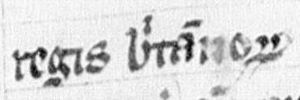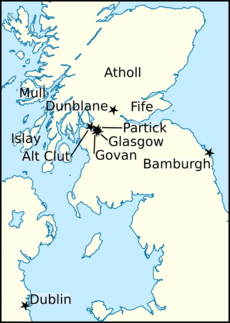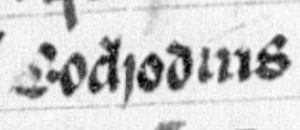Rhun ab Arthgal facts for kids
Quick facts for kids Rhun ab Arthgal |
|
|---|---|

Rhun's title as it appears on folio 29r of Paris Bibliothèque Nationale Latin 4126 (the Poppleton manuscript): "regis Britannorum" ("king of the Britons").
|
|
| King of Strathclyde | |
| Predecessor | Arthgal ap Dyfnwal |
| Issue |
|
| Father | Arthgal ap Dyfnwal |
Rhun ab Arthgal was a king in the 800s. He ruled a kingdom in what is now Scotland. He was the only known son of Arthgal ap Dyfnwal, who was the King of Alt Clut.
In 870, during his father's rule, a very important fortress called Alt Clut was attacked. Vikings captured it. Arthgal and his family might have been taken as prisoners to Ireland. Two years later, Arthgal was killed. This happened because Causantín mac Cináeda, King of the Picts wanted him dead. The reasons for this are not fully known. Rhun was married to Causantín's sister. This family link might explain why Causantín got involved in the kingship of Alt Clut.
After the Vikings destroyed Alt Clut, the kingdom changed. It moved its main area to the River Clyde valley. Because of this, the kingdom became known as the Kingdom of Strathclyde. Rhun or his father could have been the first kings of this new Strathclyde. For a while, the kingdom might have been controlled by the Picts or the Vikings. Even though Rhun was related to the Pictish king, they might have had conflicts.
We don't know exactly when Rhun stopped being king or when he died. He might have died in 876, around the same time Causantín was killed fighting Vikings. Rhun's son, Eochaid, became king after Causantín's successor, Áed mac Cináeda, died in 878.
Contents
Rhun's Family and Connections
We know about Rhun's family from old Welsh family records. These records are called the Harleian genealogies. They show that Rhun was the son of Arthgal ap Dyfnwal, King of Alt Clut. He came from a long line of kings of Alt Clut. Rhun is the only son of Arthgal that we know about.
Around 849, a historical record called the Chronicle of the Kings of Alba says that Britons burned Dunblane. This was an important religious place near the Pictish border. This attack happened when Cináed mac Ailpín, King of the Picts, was ruling. Rhun's father or grandfather might have led this attack. Burning Dunblane could mean that the Kingdom of Alt Clut was trying to expand its power. They might have taken advantage of the chaos caused by Viking attacks on the Picts.

The Chronicle of the Kings of Alba also says that Rhun married a daughter of King Cináed. This marriage might have helped improve relations between the Britons and the Picts. This could have happened after the attack on Dunblane in 849. Rhun is the last king listed in the Harleian family tree. This might mean the family tree was made when he was active, perhaps when he got married or became king. Rhun and Cináed's daughter had a son named Eochaid.
An old text called the Prophecy of Berchán describes Eochaid as "the son of the woman from Dún Guaire." Dún Guaire might refer to Bamburgh in England. It could also be a place in the Hebrides. If Rhun's wife was linked to this fort, it might mean she had been married before.
The Fall of Alt Clut

In 870, during Rhun's father's rule, the fortress of Alt Clut was attacked. Two Viking kings, Amlaíb and Ímar, captured and destroyed it. They blockaded the fortress for four months. The next year, old records show that Amlaíb and Ímar returned to Ireland. They had a large fleet of two hundred ships. They also had many prisoners, including English, Britons, and Picts. These prisoners might have been held for ransom or sold as slaves. It's possible that Arthgal and his family were among these prisoners.

Arthgal died in 872. Records say he was killed because King Causantín of the Picts wanted it. If Rhun became king after Arthgal, we don't know how long he lived after his father. We don't know why Arthgal was killed. But since Causantín and Rhun were related by marriage, it's possible Causantín arranged Arthgal's death to help Rhun become king. Maybe Rhun was living at the Pictish court when his father's kingdom was attacked. Causantín might have acted to remove any rivals Rhun had for the British kingship.
Another idea is that Arthgal ruled as a puppet king for the Vikings after Alt Clut was conquered. Vikings sometimes used puppet kings in other conquered lands. If this was true, it could explain why Causantín killed Arthgal. It would also explain why his brother-in-law, Rhun, became king. Killing Arthgal would have removed a rival for Causantín. It would also have increased Causantín's power.
After Alt Clut was destroyed, the capital of the kingdom moved. It moved up the River Clyde to places like Govan and Partick. Govan was used by earlier kings. Partick might have been used even earlier.
The kingdom's name also changed. Before the fall of Alt Clut, rulers were called kings of Alt Clut. After the fortress was lost, the kingdom became known as the Kingdom of Strathclyde. This was because it focused on the Clyde valley. Arthgal himself was called "King of the Strathclyde Britons" when he died in 872. This was the first time Irish records used this name. He or Rhun could have been the first king of this new Strathclyde.
Rhun as King of Strathclyde
Rhun likely became king soon after his father died in 872. The Chronicle of the Kings of Alba calls Rhun the "king of the Britons." An old text, the Prophecy of Berchán, suggests there might have been conflict between Rhun and his brother-in-law, Causantín. This text says Causantín won four battles. The first three were against Vikings. The fourth was at a place possibly near Glasgow. There, he defeated the "king of the Britons of the green mantles." This unnamed king might have been Arthgal. But it could also refer to Rhun himself. If it was Rhun, this conflict might have happened after his father's death. It could have been Rhun trying to keep his kingdom independent from Pictish control.
In 875, during Rhun's rule, the Picts suffered a big loss to the Vikings at Dollar. The Vikings then stayed in the area for a year. This Viking attack might be linked to campaigns by Hálfdan against the Picts and Strathclyde Britons in 875-876. These battles show that the Kingdom of Strathclyde was not fully taken over by the Vikings.
Rhun's Death and Successors
We don't know exactly when Rhun died or when his rule ended. He might have died in 876, the same year Causantín was likely killed by Vikings. If Causantín controlled Strathclyde at that time, Rhun might have died fighting alongside him. We also don't know who became king of Strathclyde right after Rhun. If both Rhun and Causantín died in 876, Rhun's son Eochaid might have become the British king. Causantín's brother, Áed mac Cináeda, became King of the Picts and ruled for two years.
The Prophecy of Berchán suggests that Eochaid ruled as king until he was forced out. Another record, the Chronicle of the Kings of Alba, says that Eochaid and a man named Giric shared the kingship. It also says Giric was Eochaid's "foster-father" or "king-maker." Both men were later removed from power. One idea is that Giric became king after Áed, and Eochaid became king after Rhun. Another idea is that Giric and Eochaid ruled together after Áed. Eochaid's mother was from a powerful Pictish family, which might have given him a claim to the Pictish throne. Rhun might have had another son named Dyfnwal. Dyfnwal ruled the Kingdom of Strathclyde into the early 900s.
Images for kids






